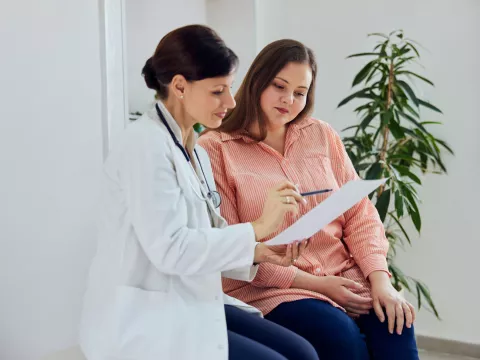- UChicago Medicine AdventHealth

Choose the health content that’s right for you, and get it delivered right in your inbox.
Endometriosis affects one in 10 women during their reproductive years. And if you’re one of them, you know just how painful it can be. We hope you’ll take comfort in knowing you aren’t alone — and that there are things you can do to find relief.
What to Know When About an Endometriosis Diagnosis
Tissue layers grow to line the inside of the uterus every month to prepare your body for pregnancy. But when these layers grow outside of the uterus — like the pelvic area, abdominal lining or around other internal organs — it can cause symptoms such as:
- Chronic inflammation
- Fatigue
- Fertility challenges
- Increased heart disease risk
- Menstrual abnormalities
- Painful scar tissue buildup
Your doctor can use certain tests and procedures to confirm a diagnosis.
While there’s no cure for endometriosis, there are ways to tame flare-ups and manage your condition.
Endometriosis Treatment Options
Whether you’re newly diagnosed, or have lived with endometriosis for a while, there’s always more to learn or try when it comes to easing your symptoms and improving your quality of life. Options range from lifestyle changes you can make in your everyday routine to medications and medical therapies your care team can provide.
Therapy choices will depend on:
- Your age
- Location and type of symptoms
- Severity of your symptoms and condition
- Whether you hope to have children
Be kind to yourself as you find your way forward. It will take time to see what works while balancing symptom relief and side effects.
Lifestyle Changes
Your care team will make several suggestions you can make part of your personal care routine to help alleviate or lessen bothersome symptoms, including:
- Amping up your workouts. Moving more can cause your estrogen levels to drop, which means you may have fewer, and lighter, periods.
- Eating healthy. Making changes to your diet, like limiting foods that cause inflammation, can go a long way towards feeling better.
- Limiting alcohol. Since alcohol raises your estrogen levels, drinking alcoholic beverages can lead to painful symptoms.
- Taking steps to relax and clear your mind. Stress can worsen symptoms and make you more sensitive to pain. Be sure to make time for activities that nurture your spirit.
- Using a warm compress or bath. Applying gentle heat to your abdomen can soothe cramping and bloating.
Medication
Medical therapies for endometriosis can help relieve pain and cramps that are usually at their worst during your period. For milder symptoms, providers may recommend nonsteroidal anti-inflammatory drugs (NSAIDs), such as ibuprofen, or others available without a prescription. For severe symptoms, providers may recommend prescription pain relievers.
Hormone Therapy
Hormone therapies for endometriosis can come as pills, shots, injections or even nasal sprays. Depending on the therapy, they may:
- Cause endometriosis patches to cycle like your period to limit symptoms
- Change your perception of pain
- Prevent new patches and scars from developing
- Stop ovaries from producing estrogen and other hormones to slow tissue growth
Ask your doctor about the latest, best and safest choices for you. New therapies are always in the research pipelines.
Surgical Procedures
If you have advanced endometriosis, experience extreme pain or are trying to conceive, surgery for endometriosis may help. However, it is possible for symptoms to return over time. In most situations, surgeons use minimally invasive approaches to find, identify and remove endometrial tissue patches or scarring.
Endometriosis and Fertility
Endometriosis can make it difficult, but not necessarily impossible, to get pregnant. Your doctor can recommend steps or refer you to a specialist for these or other options:
- Medical therapies. Certain medications increase the chance of pregnancy by helping your ovaries produce more eggs.
- In vitro fertilization. These procedures combine eggs and sperm outside of your body for implantation in the womb.
In some cases, a hysterectomy can also help alleviate symptoms. However, this will result in early menopause and come with related symptoms and risks. Since there are other ways to remove endometriosis tissue, this surgery is typically only a treatment option for the most severe situations.
Where to Start
Healthy habits — like catching your z’s, staying active, laughing a lot and keeping stress in check — can help. But when you need more support, it’s important to consult a trusted care provider who can walk you through available treatment options and help you decide which is right for you. Our women’s health care experts are ready to help you navigate your condition and treatment.

